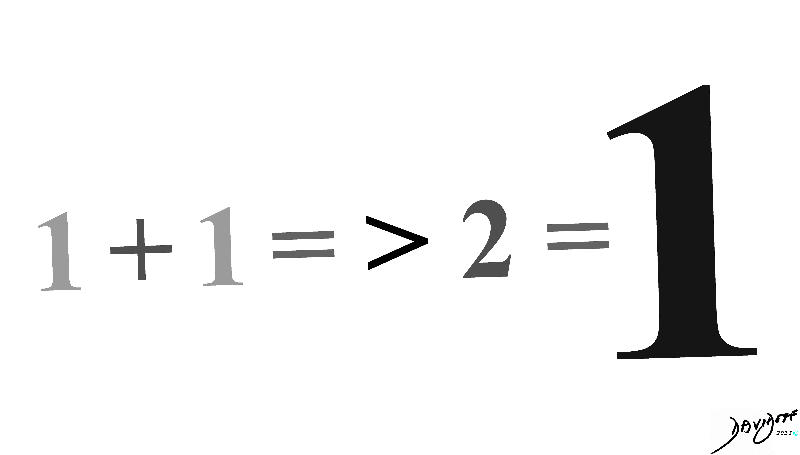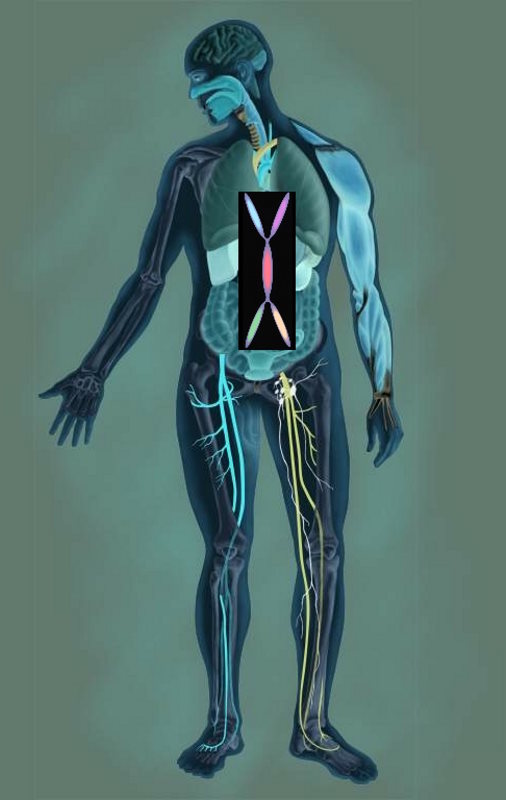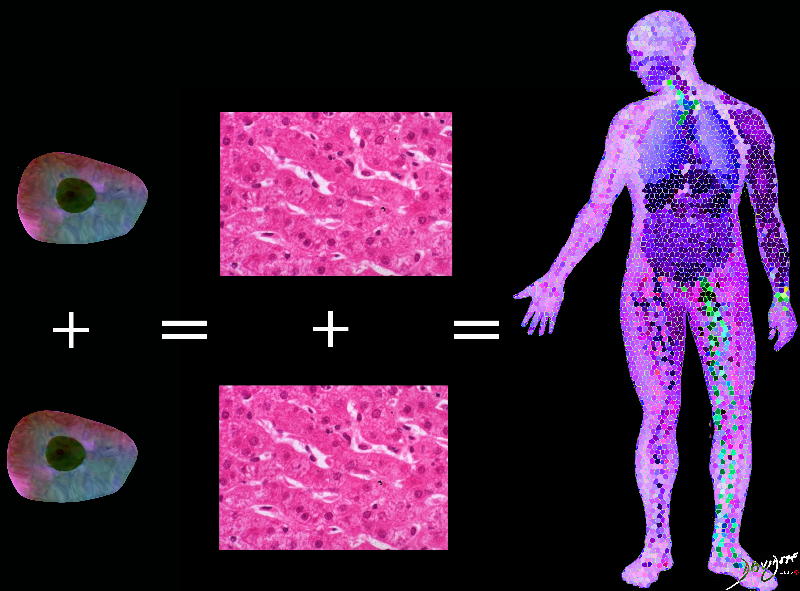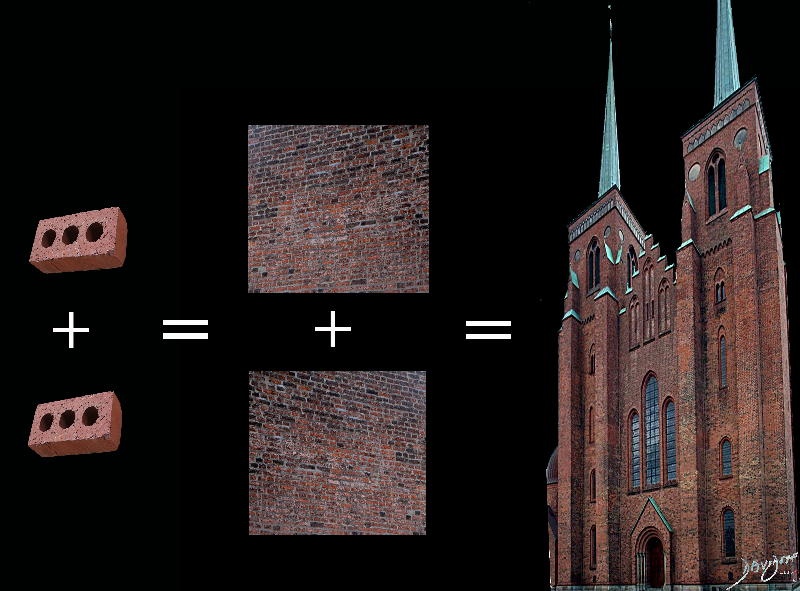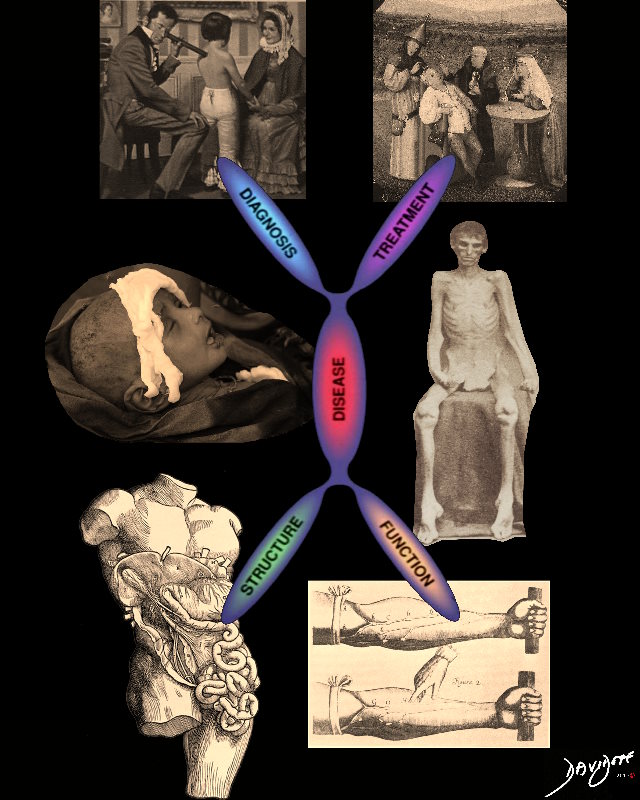The Approach of The Common Vein
- Initial Aim in the Context of Medical Education
- To integrate
- Structure and Function in
- Health and Disease
- To integrate
As the project grew it became obvious that the principles of biology were applicable to many other systems in the world not only within us , but also around us
The founding tenet in the form of an equation
Universal Equation
This simple equation states that when two compatible units combine in a given context, the result is often bigger and more powerful than the individual parts.
Note that the “1’s on the left side of the equation need to be bonded in order for the equation to have an outcome. It is the function of the “+” sign in the equation that facilitates the bond and enables a meaningful outcome
This equation not only encompasses all of biology but has far reaching application to the atom on the one extreme of our human experience and the planets of the universe on the other extreme.
The first order of understanding in biology therefore, is to identify the units or bricks of biology – ie defining the parts that make up the whole.
The second order of understanding therefore is to identify the bonds or forces that bridge and connect all the parts in biology
The Common Vein Icon
The Common Vein (TCV) icon shows complex internal anatomy of an adult person. At the inner core there is a simple diagram with 5 parts reflecting the 5 basic principles which are at the essence of the complexity of biology and medicine. These will be explored in depth. The roots reflect structure and function that combine to form the body, and the 2 upper arms are the consequences when these structure and function combin in a given environment ie – health or order, or disease or disorder
Structure and function start with the electron and proton of the simplest atom , hydrogen , with the equation applying in recurring levels of complexity through human biology to communities, cities, state, countries, the solar system and to the universe (see diagram below)
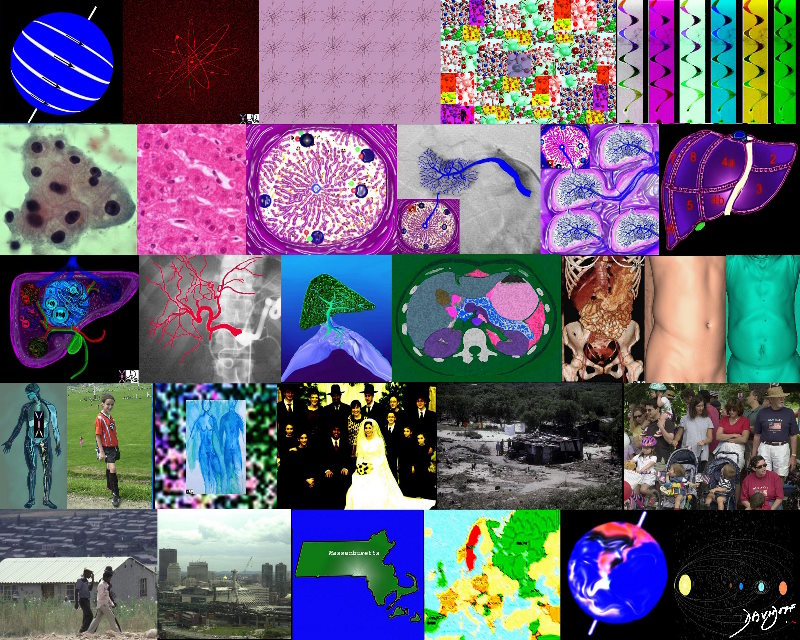
The collage takes us from the proton (top left) through to element and molecule and finally to strands of DNA in the first row. The second row starts with a group of cells, advances to the tissues, to the organ which in this case is the liver.
The third row represents units2unity from the organ (liver with its connections (arteries and veins to body systems and the body.
The fourth row advances from the body to the person, couple family home community.
The last row is the village advancing to the city, state country earth and solar system.
Note the similarity between the proton and the earth, and between the atom and solar system.
13440c11.8 Davidoff art copyright 2008
Beyond the earth to the solar systems, the planets orbit around the sun with an organizational resemblance of the electrons spinning around the proton of the atom. The ongoing building of the universe from planetary bodies, provides cause to ponder about an integrated and unified system. Biology lies within this continuum.
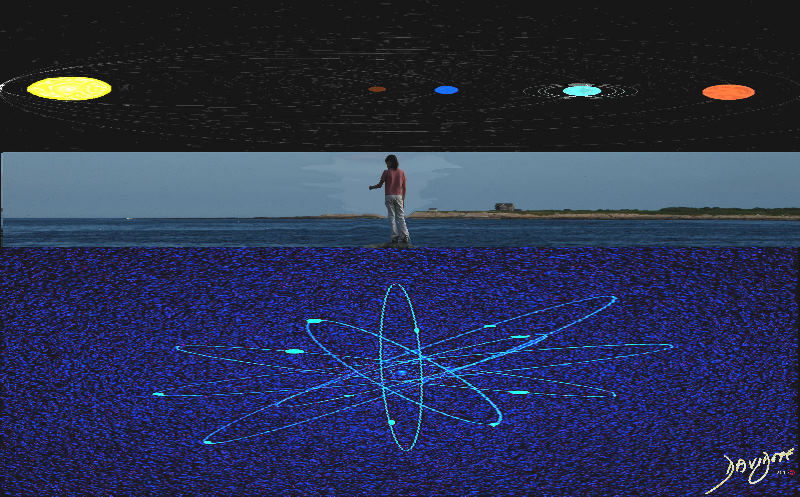
Where does biology fit in between the atom and the solar system and universe?
The atom, the building block of all structure, is seen at the bottom while the solar system, its analog in structure , has been positioned at the top of the image. Between the two stands my daughter, Danielle, on the beaches of Newport, Rhode Island, pondering at the age of nine years where she and the rest of biology fit into the grand scheme of things.
Another artistic piece below illustrates the suggested continuum of a unified pattern
big-bang-0053-catalogue-small-sign.jpg
From the Hydrogen Atom to the SunThe image shows the hydrogen atom spinning within the core of the person who represents human biology. The hydrogen atom is the basic building block of the universe and biology. The dancer is surrounded by a sphere of cells, which lie within the complex biology of the earth (heterogeneous, multicolored sphere) with its large body of water (blue ring). Note the similarity of the magnetic field of the earth depicting the earth?s axis with the electromagnetic field of the atom. The earth lies within the warmth of the sun (deep orange) and the universe lies beyond. Survival of biology requires warmth, water, energy, gravity and electromagnetism. The sun provides the warmth, the earth provides the water, its biology provides food and required energy, and the hydrogen atom and its derivatives provide electromagnetism. They form a unit of innumerable parts, with biology dependent on a fine balance of all of them.
Copyright 2017 Courtesy Ashley Davidoff MD 13451b17e01.95k.8s
Explanation of the title ? The Common Vein
The Common Vein explores the common principles that provide infrastructure to biology.
Why ?vein?? In order to build, the parts have to be linked or bonded by a variety of available forces. Without the connectors of the body such as the veins, arteries, nerves and lymphatics for example, all the parts of the body would not be able to function for the common cause of providing life. In the equation 1 + 1 = 1, the ?+? is the bond that brings the two parts together to create a new unit ? the bigger ?1?. In the context of the title ? the ?vein? is one of the structures in the body that bonds the parts.
Biology is the ?study of life?. TCV pursues the understanding of life within the body as well as life as we see and experience it in the world around us. Subjects that are seemingly unrelated such as art, literature, poetry, dance, rugby, the big bang, gardens, religion, war, politics, urban planning, cancer, architecture, family dynamics, and romance, have a common pattern that is based in the principles of biology. Once the principles that govern life are identified and explored, the pattern becomes obvious.
Aim:
The aim of the project is to provide a perspective? a place from which to look at the world and life. Providing a context for biology facilitates appreciation, understanding, and insight into the life within us and around us.
Understanding is enhanced by using similes. We comprehend when we can draw parallels in our experience. For example one can get a sense of the relationship of the cell to the body by drawing a parallel with the relationship of the brick to the building.
The Cell to the Body
Cells combine to form tissues, which combine to form organs which combine to form the body.
The Brick to the Building
Bricks combine to form a wall, which combine to form rooms which combine to form the building.
The essence of The Common Vein therefore, is to explore human biology ? the units, the forces, and the bonds that drive them to become more whole. We start with a unit which is driven by a force to bond with another unit to form a larger unit which is more powerful than its component parts and seemingly more whole. Units also have to organize as they grow larger to conserve energy. Along the way impediments such as disease happens. Disease causes disorder which stalls the process of wholeness. The field of medicine attempts to reorder the system. TCV applies these perspectives specifically to biology and medicine in order to bring understanding of life ? our life ? your life!
Units Bonds and Forces.
There is a recurring pattern of organization in our world-
There are three major components;
units or parts that make up the whole
bonds, links, or connections that bring the parts together to wholeness with the aid of
forces or energies (often invisible) that drive the units to become more whole with a yearning of wholeness
Units, bond, and forces exist in time and space.
Matter
Matter exists in a state of order or disorder; ? stability or instability
Framework for TCV
The Common Vein pursues understanding of human biology and disease. The framework of these disciplines are conceptualized into 5 tenets:
structure, function, disease, diagnosis, and treatment.
Structure deals with morphology of the biological units.
Function relates to the forces used and produced as structures work together in order to sustain life. Physiology attempts to understand how and why biology works.
Disease occurs as a result of disordered structure and function due a variety of causes.
Diagnosis is the discipline applied to finding out the structural and functional consequences of disease
Treatment is the method employed to prevent disease or try to restore structure and function to order.
Images and Imagery
For some words speak louder than the pictures., and for others a picture speaks a thousand words.
Humans have used the written word to explore and explain structure function, disease, diagnosis and the treatment of disorder in the body
TCV is rich in imagery, and in so doing brings an artistic and creative element to transmit factual information as well as ideas
Chest of Fruit
Davidoff Art Copyright 2014
Simplicity Underlying Complexity
Within the equation E= mc2 there is complexity beyond most mortals. Within the word ?heart? there is an encyclopedia of information. For the student who wants to master the knowledge base of the heart, a step-wise progressive approach from simplicity to complexity is employed. In order to understand the complexity, TCV starts with the single and simple, and progressively builds to complexity. The model is conceptually likened to an inverted cone or pyramid, where the pointed bottom end represents the single and the simple and upside down pyramid progresses to complexity both in depth and breadth.
From Simplicity to Complexity in Progressive Stepwise Format
Davidoff Art Copyright 2014
The heart for example is defined by its structure, function, diseases and the diagnostic and therapeutic methods utilized to understand its disorders.
The definition therefore, takes the word ?heart? to a sentence of information including the essence of its structure (eg muscle), function (eg pump), diseases (eg congestive heart failure, coronary artery disease) diagnosis (EKG, echocardiogram) and treatment (preventive measures, pharmaceuticals and surgery).
As the information chain advances each of these elements are expanded .
Drawing Parallels
Understanding is also enhanced by using similes. We comprehend when we can draw parallels in our experience. For example one can get a sense of the relationship of the cell to the tissue by drawing a parallel of the relationship between the brick and a wall.
The essence of The Common Vein is to understand the units, the bonds and the forces that drive them to become whole.
This site is a crystallized version and updated version of thecommonvein.com .
The Common Vein is about the principles that govern our biological world. While “common” refers to the common tenets that govern biology and medicine, “vein” refers to the links that connect and keep units together and viable.
The introductory module is outlined below in keeping with the stepwise approach to learning. Each of the categories discussed below are described in a few sentences which progress in complexity as the project unfolds. Thus the intent of the first group of introductory chapters, is to paint a broad picture soas to give us a starting point for the learning, and to give context to the detail to come.
There is a firm belief that underlying complexity there is simplicity. In order to understand the complexity, one should start out with the single and simple, and progressively, in stepwise fashion build to complexity. We have likened this model conceptually to an inverted cone or pyramid, where the bottom as a point repesents the single and the simple and upside down pyramid progresses to complexity both in depth and breadth.

